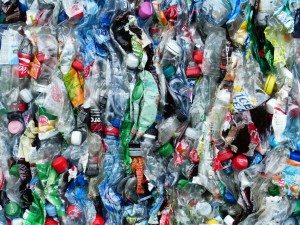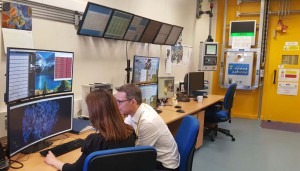The inner workings of a recently discovered bacterium with a fascinating ability to use plastic as an energy source have been recently revealed in PNAS. The world’s unique Long-Wavelength Macromolecular Crystallography (MX) beamline here at Diamond Light Source was used to successfully solve the structure of the bacterial enzyme responsible for chopping up the plastic. This newly evolved enzyme could be the key to tackling the worldwide problem of plastic waste.
Plastic pollution is a global threat that desperately needs addressing. Plastics are rarely biodegradable and they can remain in the environment for centuries. One of the most abundant plastics that contributes hugely to this dire situation is poly(ethylene terephthalate) (PET).
 PET is used largely in textiles, where it is commonly referred to as polyester, but it is also used as packaging for liquids and foodstuffs. In fact, PET’s excellent water-repellent properties led to it being the plastic of choice for soft drink bottles. However, once plastic bottles are discarded in the environment the water resistance of PET means that they are highly resistant to natural biodegradation. PET bottles can linger for hundreds of years and plastic waste like this will accumulate over time unless a solution is found to degrade them.
PET is used largely in textiles, where it is commonly referred to as polyester, but it is also used as packaging for liquids and foodstuffs. In fact, PET’s excellent water-repellent properties led to it being the plastic of choice for soft drink bottles. However, once plastic bottles are discarded in the environment the water resistance of PET means that they are highly resistant to natural biodegradation. PET bottles can linger for hundreds of years and plastic waste like this will accumulate over time unless a solution is found to degrade them.
A recent breakthrough came in the discovery of a unique bacterium, Ideonella sakaiensis 201-F6, which was found feeding on waste from an industrial PET recycling facility. PET has only been widely used since the 1970s, so the bacterium had evolved at breakneck speed to be able to take advantage of the new food source.
The bacterium had the amazing ability to degrade PET and use it to provide carbon for energy. Central to this ability was the production of a PET-digesting enzyme, known as PETase.
A concerted effort by scientists from the University of Portsmouth, the National Renewable Energy Laboratory in Colorado, the University of South Florida, the University of Campinas in Sao Paulo and Diamond Light Source attempted to uncover more details about the intriguing enzyme. Their main approach was to determine the 3D structure of PETase at an extremely high resolution using the Long-Wavelength Macromolecular Crystallography beamline (I23) at Diamond, the only beamline of its kind across the globe.
“With input from five institutions in three different countries, this research is a fine example of how international collaboration can help make significant scientific breakthroughs.
“The detail that the team were able to draw out from the results achieved on the I23 beamline at Diamond will be invaluable in looking to tailor the enzyme for use in large-scale industrial recycling processes. The impact of such an innovative solution to plastic waste would be global. It is fantastic that UK scientists and facilities are helping to lead the way.” (- Prof Andrew Harrison, CEO of Diamond)
The team initially had to prepare large quantities of purified PETase for their analyses, which were then crystallised under different conditions. The crystals were subjected to X-ray crystallography at Diamond and the resulting structural information had an exceptional resolution of 0.92 Å. It was noted that PETase looked quite similar to an enzyme it had likely evolved from known as cutinase; however, there was a difference in the size of the active site cleft – near to where the enzyme gets to grips with its target. It is thought that the wide active site cleft on the PETase enables it to accommodate the bulky components of PET to break it down.
 To further explore the structure of the active site, the researchers conducted molecular simulations of PETase and cutinase. They saw that PETase had a more mobile active site than cutinase, being composed of numerous flexible loops of amino acids. Again, this was probably to fit the larger groups that make up PET.
To further explore the structure of the active site, the researchers conducted molecular simulations of PETase and cutinase. They saw that PETase had a more mobile active site than cutinase, being composed of numerous flexible loops of amino acids. Again, this was probably to fit the larger groups that make up PET.
To see PETase in action, the scientists next set up samples of the enzyme with PET in test tubes under different conditions and examined the samples using electron microscopy. Incredibly, PETase degraded samples of PET from a commercial soft drink bottle, and the extent of degradation was influenced by pH, crystallinity and even morphology of the samples.
They also screened PETase activity in this manner against a variety of other types of plastics. One such plastic, polyethylene-2,5-furandicarboxylate (PEF) was also degraded by PETase, indicating a dual role for this fascinating enzyme. PEF is an upcoming plastic that is hailed as a ‘bio-based’ PET alternative, so it is encouraging that a means of recycling it are already in development before it becomes as widespread as PET.
Not only have the team determined the precise structure of PETase but have also engineered an improved variant of PETase.
“The Long-Wavelength MX beamline I23 at Diamond is an incredibly advanced and unique facility that enables us to solve structures that are usually difficult to characterise. In the case of PETase, the protein crystals diffracted really well and we were able to achieve very high resolution. While most of the known protein structures have been determined to resolutions between 1.5 and 3.0 Å (0.15 – 0.3 nanometres), and we could achieve from for one of the investigated structures 0.92 Å. It basically makes what we are looking at much clearer and therefore easier to understand.
“The high resolution 3D structure allowed us to get a clear picture of where the enzyme grips its target which then informed the next step of computational modelling to investigate the mechanism of PET degradation further. The large, curved area detector in combination with the vacuum environment on the I23 beamline is ideal for this work as it allows high resolution structure determinations at low X-ray doses limiting detrimental radiation damage effects to the crystals.”
(- Dr Armin Wagner, Principal Beamline Scientist of I23)
The scientists are keen to harness the activity of PETase to combat the accruing mass of plastic waste, but they expect protein engineering will be needed to fully realise its potential. In particular, the insights into its active site garnered from I23 will be invaluable in designing a highly-efficient plastic-degrading machine. It is thought that tailored PETases like these could be used for large-scale industrial recycling processes which would offer an innovative solution to plastic waste that we so desperately need.
Source
Diamond Light Source, press release, 2018-04-16.
Supplier
Diamond Light Source
National Renewable Energy Laboratory (NREL)
Proceedings of the National Academy of Sciences of the USA (PNAS)
University of Campinas - UNICAMP
University of Plymouth
University of South Florida
Share
Renewable Carbon News – Daily Newsletter
Subscribe to our daily email newsletter – the world's leading newsletter on renewable materials and chemicals










